Hands On With the LG V20
by Joshua Ho on September 8, 2016 7:00 AM EST- Posted in
- Smartphones
- Qualcomm
- LG
- Android
- Mobile
- Snapdragon 820
- Android N
- LG V20
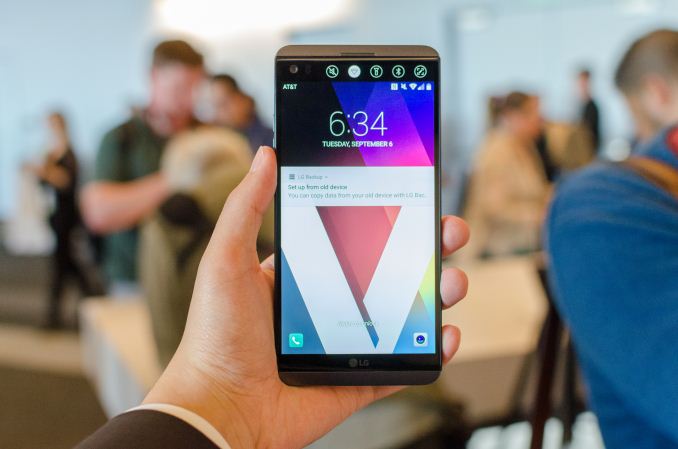
The LG V20 at this point has been leaked to death, but it’s finally here. LG has been pushing through a fairly tough year, so this phone really could not have arrived at a better time with the Note7’s battery fires and recalls as the obvious alternative to the Note7. To try and start our discussion of the LG V20 we can first take a look at the specs before we jump into the other major areas of note.
| LG Smartphones | |||
| LG V20 | LG G5 | LG V10 | |
| SoC | Qualcomm Snapdragon 820 2x Kryo @ 2.15GHz 2x Kryo @ 1.59GHz Adreno 530 @ 624MHz |
Qualcomm Snapdragon 820 2x Kryo @ 2.15GHz 2x Kryo @ 1.59GHz Adreno 530 @ 624MHz |
Qualcomm Snapdragon 808 2x A57 @ 1.82GHz 4x A53 @ 1.44GHz Adreno 418 |
| RAM | 4GB LPDDR4 | 4GB LPDDR4-3188 | 4GB LPDDR3 |
| NAND | 64GB (UFS 2.0) + microSD |
32GB (UFS 2.0) + microSD |
32GB/64GB + microSD |
| Display | 5.7-inch 2560x1440 IPS LCD 2.1-inch 160x1040 LCD (Secondary) |
5.3-inch 2560x1440 IPS LCD | 5.7-inch 2560x1440 IPS LCD 2.1-inch 160x1040 LCD (Secondary) |
| Dimensions | 159.7 x 78.1 x 7.6 mm 174 grams |
149.4 x 73.9 x 7.7 mm 159 grams |
159.6 x 79.3 x 8.6 mm 192 grams |
| Modem | Qualcomm X12 (Integrated) 2G / 3G / 4G LTE (Category 12/13) |
Qualcomm X12 (Integrated) 2G / 3G / 4G LTE (Category 12/13) |
Qualcomm X10 (Integrated) 2G / 3G / 4G LTE (Category 6/9) |
| SIM Size | NanoSIM | NanoSIM | NanoSIM |
| Front Camera | 5MP, f/1.9 | 8MP, 1/4" Toshiba T4KA3, 1.12µm pixels, f/2.0, HDR, screen flash | Primary: 5MP, f/2.2 |
| Wide Angle: 5MP, f/2.2 | |||
| Rear Camera | Primary: 16MP, f/1.8 Sony IMX298 Exmor RS Laser AF, PDAF, OIS, LED flash |
Primary: 16MP, 1/2.6" Sony IMX234 Exmor RS, 1.12µm pixels, f/1.8, Laser AF, 3-axis OIS, HDR, color spectrum sensor, LED flash | 16MP, f/1.8 Laser AF, OIS, LED flash |
| Wide Angle: 8MP, f/2.4, Sony IMX219 Exmor R Laser AF, PDAF, OIS, LED flash |
Wide Angle: 8MP, Sony IMX268 Exmor RS, 1.12µm pixels (assumed), f/2.4, wide-angle (135°), Laser AF, OIS, HDR, color spectrum sensor, LED flash | ||
| Battery | 3200 mAh (12.3 Wh) replaceable |
2800 mAh (10.78 Wh) replaceable |
3000 mAh (11.55 Wh) replaceable |
| Connectivity | 802.11a/b/g/n/ac, BT 4.2, NFC, IrLED, GPS/GNSS, DLNA, USB 2.0 Type-C | 802.11a/b/g/n/ac 2x2 MIMO, BT 4.2, NFC, IrLED, GPS/GNSS, SlimPort, DLNA, USB 2.0 Type-C, LG Modular Port | 802.11a/b/g/n/ac, BT 4.1, NFC, GPS/GNSS, SlimPort, DLNA, microUSB 2.0 |
| Launch OS | Android 7 with LGUX 5.0 | Android 6.0.1 with LGUX 5.0 | Android 5.1 with LGUX 4.0 |
At a high level, the LG V20 honestly doesn’t look all that different from the LG G5 in a lot of ways. It shares the same SoC, the same rear camera, and retains the rear-mounted fingerprint scanner that also doubles as a power button. However, there is a bump in battery size and display size, and things like the new front-facing camera and secondary display help to differentiate it from the LG G5.
However, the single biggest change here is design. While the LG V10 had a plastic back cover and a glossy stainless steel frame, the LG V20 adopts a fairly elegant aluminum design. The phone has a metal frame to give it strength, which holds the major components and provides the screw holes for the plastic cover that helps to protect the internal components. Over this plastic cover, LG adds the aluminum back cover. This aluminum back cover appears to house the NFC antenna but not much else other than a whole host of grounding points. All other antennas are probably in the top and bottom RF windows for this device. Judging by the writing that says BYD on this back cover, it wouldn’t be a surprise to know that BYD Electronic is making these back covers for LG.
Overall, I think this phone feels like a massive step ahead the G5 when it comes to in-hand feel and overall design. LG is quite possibly the only OEM that has ever properly integrated a removable battery and an aluminum back cover at this point, and while this is a pre-production unit my subjective opinion here is that this is actually a fairly handsome design. The earpiece has this fine detail to it and it’s pushed up right along the edge of the glass. Even the LG logo is subdued, and is color matched fairly well to the plastic that flanks the display. On the back of the phone, everything is aligned fairly well. This isn’t a huge deal as far as actual purchase recommendations go, but it’s worth mentioning because it looks like LG cares about ID even if they don’t market it aggressively.
Moving past design, things like the combined power and fingerprint scanner have gotten noticeably better moving from the G5 to the V20. The button no longer has a significant amount of slack or play that I saw in many G5s, and the button clicks much more solidly now. The volume buttons also feel great, but they appear to be placed only to work well if you hold the phone in your left hand as holding the phone in your right hand doesn’t really leave any viable method of comfortably and safely manipulating the buttons. This isn’t a huge issue if you mostly set and forget volume settings though.
Booting up the display of the LG V20 reveals no significant issues with backlight bleed, but right off the bat it’s obvious that the display is on the cold side. It’s hard to say whether this display is still making the mistake of a gamut wider than sRGB when Android doesn’t support color management, but for now I’m not going to make any snap judgments even though LG is a bit notorious for not getting color calibration right.
Playing with the camera right away it’s obvious that LG has dramatically improved their camera UI for the V series relative to the G series, which makes me wonder why the G5 shipped with such a seemingly gimped camera application. The manual camera is not necessarily anything special, but manual video settings for bitrate, audio recording, and a number of image controls is really great to see and something that I haven’t seen on any other devices out there. Audio even has low cut filters for things like concerts where bass is often overwhelming for reasons beyond me. There’s extra video stabilization, but in a hands-on context it’s difficult to test these things properly.
LG is also emphasizing audio quality, with the ESS quad DAC that has a 132 dB SNR and 124 dB of dynamic range that should make it extremely difficult to notice things like hiss when the DAC is on. Voltage output is said to be double that of anything else out on the market at time of release as well which is nice to see. This is contrasted with the LG G5, which shipped with a somewhat disappointing DAC out of the box and needed the B&O module to really get good audio quality. Seeing as how a major device launch meant the loss of the 3.5mm jack altogether it’s worth mentioning that this device does have a 3.5mm jack on the bottom right of the phone.
The final thing worth mentioning given that I’ve had some time with the preproduction unit at home is that LG is now using SK Hynix’s UFS 2.1 solution, which is supposed to allow for better security between SoC and UFS device. This is also using 3D-V2 NAND which might be the first shipping implementation of 3D NAND I’ve ever seen in a smartphone. This actually leapfrogs Samsung which is impressive to say the least.
Overall, the LG V20 is a fairly interesting phone but I get the sense that it might be overlooked in the sea of other launches to come. LG UX 5.0+ is a decent redesign at first glance but may need some extra work, but the phone itself is actually fairly good at first glance. The LG V20 will be available through Verizon, Sprint, AT&T, and T-Mobile US in Titan and Silver.



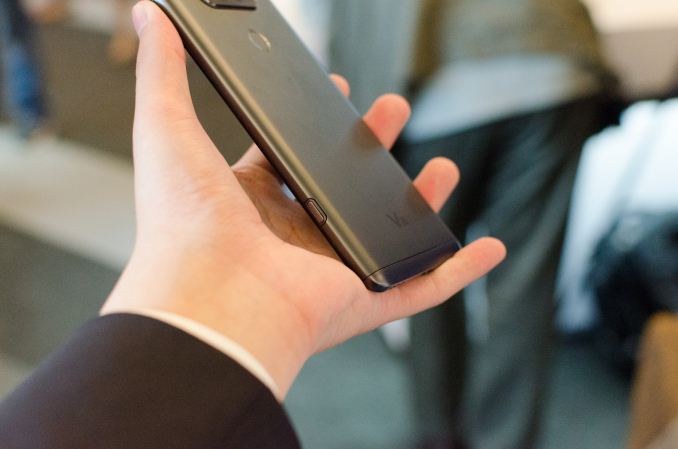
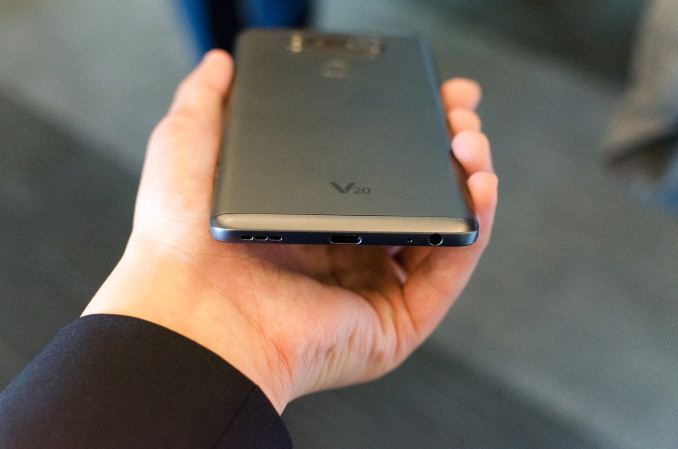
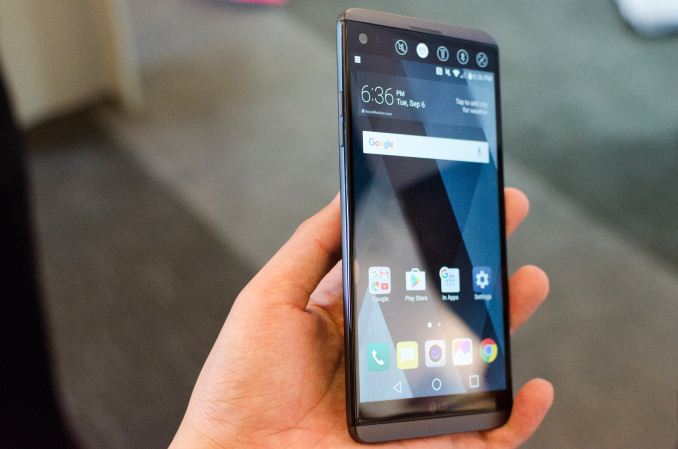
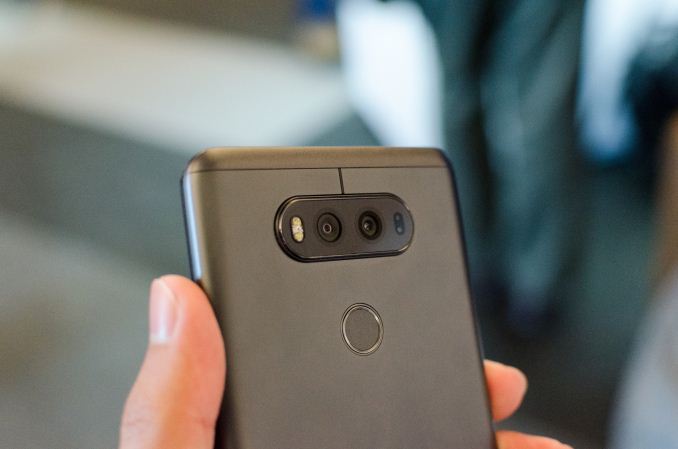
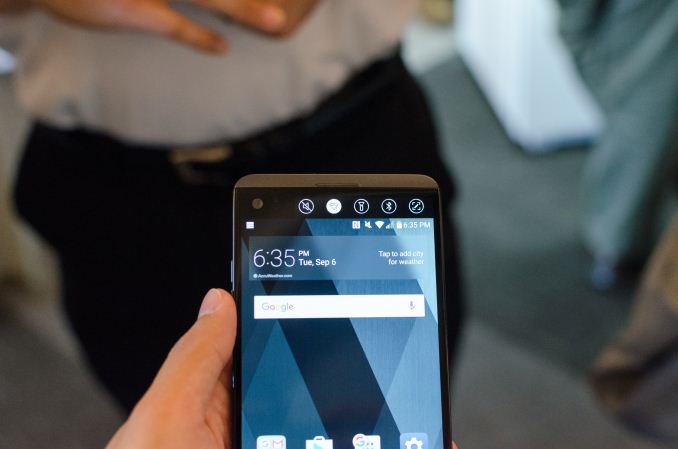
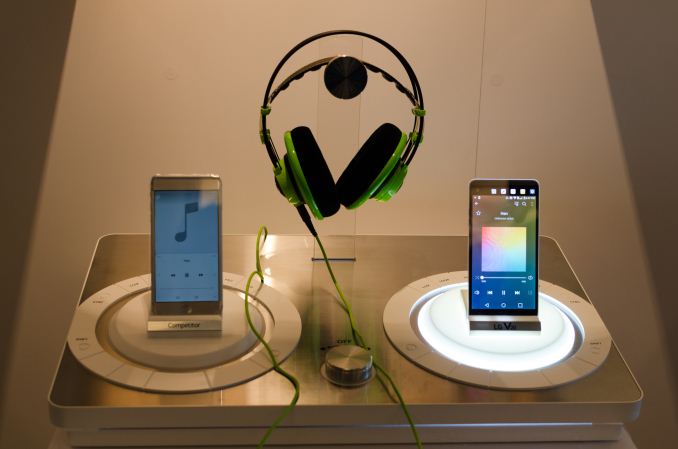
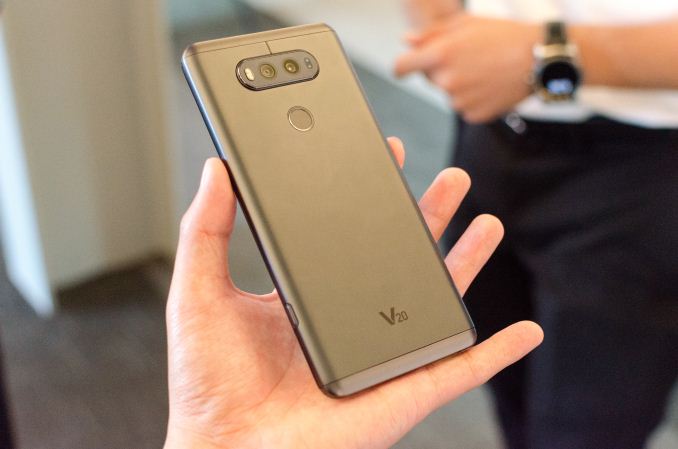








47 Comments
View All Comments
TheinsanegamerN - Thursday, September 8, 2016 - link
A removable battery?!? THE SECOND COMING OF JESUS IS HERE!At least LG hasnt lost their mind. Hopefully this makes it's way into the G6. Now the other question, has LG solved their horrible QC issues from the G4 era? I've encountered many former LG users who complained that the G3/4/5 and the v10 had bootloop issues and generally seemed to be soldered together with hope and duck tape.
philehidiot - Thursday, September 8, 2016 - link
Jesus is here and he brings premium grade solder.Ikefu - Thursday, September 8, 2016 - link
I can't speak for everyone but my V10 is rocking without ever having a case or screen protector and has survived many drops. Still boots greats and runs all day no problem. Still takes the best photos of all my friends tooMrSpadge - Thursday, September 8, 2016 - link
"but manual video settings for bitrate, audio recording, and a number of image controls is really great to see"I'd rather set the resolution and a quality slider or setting. I wouldn't really care about the bitrate, but maybe about setting "fair quality" or "high quality". And then let the system use what ever bitrate is necessary to avoid artefacts, because I don't know which value this is going to be in which scene (action vs. still etc.).
Valantar - Thursday, September 8, 2016 - link
That's the same thing, only bitrate actually tells you something meaningful, rather than arbitrarily defined and vaguely worded settings. Also, it allows for meaningful comparisons between phones/cameras, which a "good - crappy" slider does not. And I'd wager even the most tech-illiterate user understands that a higher quality setting is better, whether it's a higher number or a better superlative. If they ever come close to those settings at all, of course. Manual video modes are not meant for people who don't want manual control.DanNeely - Thursday, September 8, 2016 - link
For probably better than 99% of users a bitrate number is completely meaningless. It might be something interesting for the most advanced users to fiddle with on an extra options screen; but for everyone else a 3(?) position slider: "Smallest Size (lower quality)", "Normal", "Highest Quality (larger files)" with the middle option picked by default would be more useful.Lastly, raw bitrate itself is not enough to do meaningful comparisons between devices. In addition to variable quality of the sensor and optics, different encoding format will give significantly better/worse quality for a given bitrate and even within a single encoding format (eg h.264, HEVC, or VP9) different encoders can perform significantly better or worse with equivalent high level settings.
Meteor2 - Thursday, September 8, 2016 - link
I really think this is aimed at 'creatives'. Yep, that's a horrible term, but Instagram et al. are giving people a platform which they're using.Valantar - Thursday, September 8, 2016 - link
Of course bitrate isn't directly comparable - heck, even the quality of the ISP affects that (given that the sensor, codec and bitrate are the same). But it's a heck of a lot more comparable than "high-medium-low," especially as "high" (or "ultra" or whatever marketing bs they want to use) simply is whatever the maximum bitrate actually is. So "high" on one phone might be 20Mbps HEVC, while on another it's 10Mbps H.264.And as I said, the vast majority of users never go within ten feet of any camera quality setting, let alone video compression quality. These settings are meant for people who actually care somewhat about what they're doing, at least to the degree that they can figure out that a higher number is better. It really doesn't require you to be Einstein.
For other users, the camera maker simply needs to make sure the default quality setting is OK. No more, no less. But manual control with actual usable information attatched to it is never a bad thing.
mindurbusiness - Thursday, September 8, 2016 - link
I'm really disappointed in the LG G5 and this one. I think the best and flawless design that LG was created was the 4. I love the fact that there's no buttons to get in the way of lowering your volume by accident, the only phone that has it's own selfie camera and the screen being completely touch. I don't know why others haven't gotten on board with a no button design for phones. Having the volume and power button on the back of the phone was genius. I ended important calls, locked screens by mistake and had buttons even stop manually working because of this. LG G5 has a volume button on the side of the phone and this one has a few too.Notmyusualid - Thursday, September 8, 2016 - link
Hmm, single-sim phones....NEVER again.